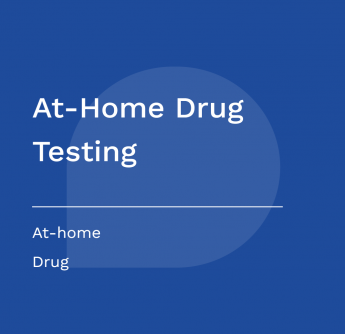At-Home Tests
At-Home Test Reviews
| Reviews | Comparisons |
|---|---|
Types of At-Home Tests
The Role of At-Home Testing
Whether you’re trying to avoid contact with a communicable disease (such as COVID-19) or you have limited mobility or ability to leave home, there are a number of reasons to seek out an at-home testing solution. New at-home lab test services are being developed by every major medical testing supplier and are gaining in both availability and accuracy.
At-home tests can be utilized for various reasons. The most common uses include:
- Diagnosis – This entails identifying the cause of a health problem after symptoms have started. For example, at-home tests may detect infectious diseases like COVID-19. It is important to note, though, that only a doctor can formally diagnose a health condition, and they will need to conduct additional tests to confirm the results of at-home testing.
- Screening – This is looking for signs of a health problem before any symptoms have occurred. For example, at-home testing can look for sexually transmitted diseases (STDs) that may not cause symptoms, which can help you avoid unknowingly spreading it to others.
- Monitoring – This is tracking how a person’s health changes over time or in response to treatment. At-home kits that allow people with diabetes to measure their blood sugar are an example of monitoring.
- Disease risk assessment: In some situations, testing can reveal when a person has a higher risk of developing a disease. For instance, some genetic tests can look for DNA mutations associated with certain types of cancer, such as BRCA gene mutations and an increased risk of breast and ovarian cancer.
- Wellness optimization: Some tests don’t look for a specific problem; instead, they are designed to help you understand one or more aspects of your physical, mental, or emotional wellness. These tests may measure hormones, nutrient levels, or other substances to offer more information about your body. Many of these tests have not been validated to improve health, so it is important to scrutinize the test kits and use them with caution.
- Ancestry research: Genetic testing can analyze your DNA to reveal information about your family history. This testing may shed light on your ancestry or even uncover unknown family relationships.
At-Home Test Reviews
Read reviews of the best at-home tests and at-home lab kits for a variety of medical concerns, from sexually transmitted diseases to high cholesterol. We reviewed dozens of at-home tests based on value, convenience, and availability for the best combination of cost, turn-around time, and ease of use. We also reviewed at-home tests for the services offered, certifications and lab safety, and professional support. Reviews are based on data including price, insurance acceptance, comprehensiveness of the tests, and how quickly you can get results or speak to a health care provider.
Types of At-Home Tests
At-home tests can be classified into three main types:
- Self-tests: This allows the entire process to be conducted at home such as a home pregnancy test. A sample is collected at home, and results are provided on-site. The test kit includes information about how to interpret the result. In most cases, self-tests provide rapid results in under an hour.
- Self-collection tests: This involves taking a sample at home and then sending it to a laboratory where it can be analyzed. Results are usually provided electronically once the lab has finished its analysis.
- Tests ordered from home: For these tests, sample collection and analysis are done in a laboratory, but a specially designed website streamlines scheduling and paying for the test. By handling all the pretest paperwork and logistics at home, this option can simplify the process and make testing more convenient.
Self-tests and self-collection tests are typically available as at-home kits designed to be self-administered, but in some cases, assistance may be provided by another person or home health professional. At-home test kits for children generally require testing to be conducted by an adult.
For people who are homebound or have specific medical needs, special at-home testing options may be available through home nursing or home health care services. Patients in need of these services should talk with their doctor or a medical social worker.
Prescription and over-the-counter at-home tests
Some at-home tests require a prescription from a licensed health professional in your state. In contrast, over-the-counter tests can be purchased either online or in a physical store without a doctor’s order.
Many providers of prescription at-home tests offer services to get the prescription required to obtain a test kit. This usually involves submitting a questionnaire or other health information so that a physician can verify that you meet the basic requirements for receiving the test.
For both prescription and over-the-counter at-home tests, it’s best to discuss testing with a doctor familiar with your health history. Your doctor can review the benefits and risks of testing, order a test if appropriate, and once you have results, explain their significance in your specific situation. Note that if your doctor did not prescribe the at-home test, they may decline to interpret the results and instead may recommend repeating the test using traditional laboratory methods.
Getting At-Home Tests
At-home tests have become widely available through a variety of outlets. Many pharmacies and drug stores sell over-the-counter tests in their physical stores and on their websites.
Major online retailers as well as online companies specializing in testing have dramatically expanded options for purchasing at-home tests.
For people who need in-home health care, services for mobile sample collection, such as mobile phlebotomy, may be arranged through a doctor or through third-party companies offering home health care with trained health professionals.
Costs of at-home tests
The cost of at-home testing can vary significantly based on the type of test, whether laboratory analysis is required, and whether coverage is provided by health insurance.
In most cases, at-home testing is not covered by insurance. Tests that are purchased at a pharmacy or online usually must be paid for entirely by the patient or customer. Many companies that offer at-home tests accept payment with funds from a health savings account (HSA) or flexible spending account (FSA).
Some insurance providers may cover at-home testing that is prescribed by a doctor in their network. Certain costs may also be covered for people with a demonstrated medical need for home health care.
Types of sample collection
The sample for an at-home test is tailored to what the test is designed to measure. Blood, urine, saliva, stool, or a respiratory swab are the most common specimens used for at-home tests.
An at-home test kit will indicate the kind of sample required such as a oral, vaginal or rectal swab. The kit will also include materials and detailed instructions for collecting your sample. Following these instructions carefully and using only materials in the kit is critical both for taking self-tests and for correctly storing a sample to send to a laboratory.
If you are planning to take an at-home test, these practical tips can help you avoid misleading or invalid results:
- Check the expiration date: Do not buy or use tests if they have expired because the materials or chemicals in the test may have lost their effectiveness.
- Store the test correctly: Follow the package directions on where and how to store the test kit. Many tests are sensitive to temperature or humidity and must be stored properly.
- Read the instructions in full before taking the test: Don’t try to take the test on the fly. Instead, make sure to read the instructions first so that you understand each step of the process and have everything you need at hand. Many testing companies now offer online videos or tutorials to guide you through taking the test correctly.
- Account for special procedures: Look carefully to see if the test has to be taken at a certain time of day or under special physical conditions like fasting.
- Follow instructions carefully: Perform the test exactly as instructed. If you have questions or are at all unsure about how to use the test, consider talking to your health care provider.
Getting results from at-home tests
If you take an at-home self-test, results are usually available in less than 60 minutes. Many rapid self-tests provide results almost immediately. The test kit itself will include a mechanism for seeing and interpreting your results.
For self-collection tests or laboratory tests that you order from home, you will generally get results through an online health portal. Because these tests require laboratory analysis and may need to be shipped to the lab, it often takes a few business days before results are available.
Sources
Ayala-Lopez N, Nichols JH. 93-1198.Benefits and Risks of Direct-to-Consumer Testing. Arch Pathol Lab Med. 2020;144(10):11 doi:10.5858/arpa.2020-0078-RA
Centers for Disease Control and Prevention. COVID-19: Self-testing at Home or Anywhere. Updated September 6, 2022. Accessed October 3, 2022. https://www.cdc.gov/coronavirus/2019-ncov/testing/self-testing.html
Court E. Quest Sees Direct-to-Consumer Testing Taking off Post-pandemic. Bloomberg. Published March 11, 2021. Accessed October 3, 2022. https://www.bloomberg.com/news/articles/2021-03-11/quest-sees-direct-to-consumer-testing-taking-off-post-pandemic
Ibitoye M, Frasca T, Giguere R, Carballo-Diéguez A. Home Testing Past, Present and Future: Lessons Learned and Implications for HIV Home Tests. AIDS Behav. 2014;18(5):933-949. doi:10.1007/s10461-013-0668-9
Procop GW, Kadkhoda K, Rhoads DD, Gordon SG, Reddy AJ. Home Testing for COVID-19: Benefits and Limitations [published online ahead of print, 2021 Mar 1]. Cleve Clin J Med. 2021;10.3949/ccjm.88a.ccc071. doi:10.3949/ccjm.88a.ccc071
Tidy EJ, Shine B, Oke J, Hayward G. Home Self-Testing Kits: Helpful or Harmful? Br J Gen Pract. 2018;68(673):360-361. doi:10.3399/bjgp18X698021
U.S. Food and Drug Administration. Direct-to-Consumer Tests. Updated December 20, 2019. Accessed October 3, 2022. https://www.fda.gov/medical-devices/in-vitro-diagnostics/direct-consumer-tests
U.S. Food and Drug Administration. FDA Executive Summary: Over-the-Counter Diagnostic Tests for the Detection of Pathogens Causing Infectious Diseases. Published August 16, 2016. Accessed October 3, 2022. https://www.fda.gov/media/99873/download
U.S. Food and Drug Administration. Home Use Tests. Updated June 21, 2022. Accessed October 3, 2022. https://www.fda.gov/medical-devices/in-vitro-diagnostics/home-use-tests
U.S. Food and Drug Administration. How You Can Get the Best Results With Home Use Tests. Updated December 28, 2017. Accessed October 3, 2022. https://www.fda.gov/medical-devices/home-use-tests/how-you-can-get-best-results-home-use-tests
U.S. Food and Drug Administration. Laboratory Developed Tests. Updated September 27, 2018. Accessed October 3, 2022. https://www.fda.gov/medical-devices/in-vitro-diagnostics/laboratory-developed-tests




